 |
|
Bio Dr. Wykoff is Chief Medical Editor of Retina Specialist Magazine and a consultant to and investigator for Kodiak Sciences. |
The 41st annual scientific meeting of the American Society of Retina Specialists in Seattle was abuzz with reports of retinal vasculitis cases in patients treated with pegcetacoplan (Syfovre, Apellis Pharmaceuticals), but that didn’t derail the multitude of trial readouts that characterize the meeting.
Here, we share four abstracts that are worth a second look.
ARCHER trial of novel ANX007 antibody fragment
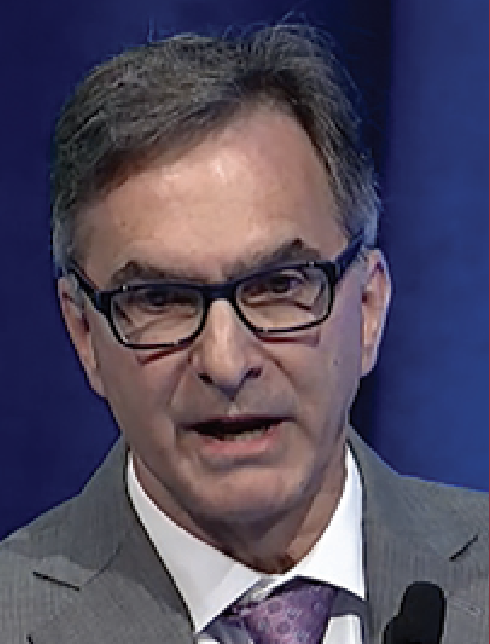 |
The ARCHER study evaluated the efficacy and safety of intravitreal ANX007 (Annexon Biosciences), a novel antibody fragment that binds to C1q, inhibiting activation of the classical complement pathway, in geographic atrophy secondary to age-related macular degeneration.1 The primary endpoint of the double-masked, sham-controlled study was comparison of the rate of change in GA lesion growth at 12 months between ANX007 and sham.
The study used three arms: sham monthly or every other month (n=89), and ANX007 5 mg monthly (n=89) or every other month (EOM, n=92).
Jeffrey Heier, MD, director of the vitreoretinal service, Ophthalmic Consultants of Boston, reported ANX007 didn’t significantly reduce lesion area compared to sham. GA change from baseline at 12 months was 2.15 mm2 for sham, 2.02 mm2 for monthly treatment (-6.2 percent, p-0.526) and 2.12 mm2 for every-other-month (EOM) treatment (-1.3 percent, p=0.896).
The study showed ANX007 provided significant dose-dependent protection from vision loss. Sham patients had a rate of 21.3 percent of ≥15-letter loss at 12 months vs. 5.6 percent for monthly ANX007 (p=0.0021) and 10.9 percent for EOM treatment (p=0.055). The pooled average for the treatment group was 8.3 percent (p=0.0024).
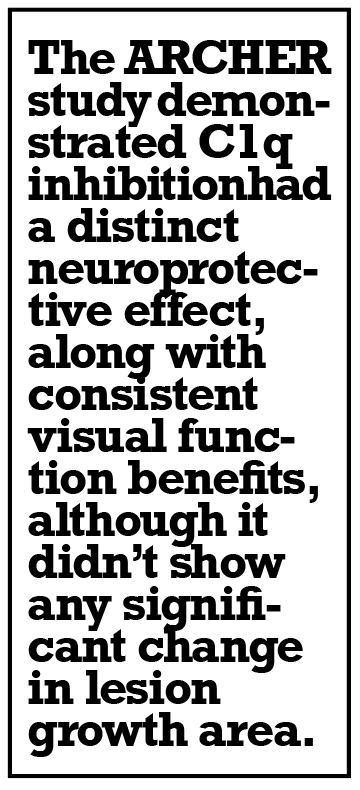 |
Treated patients also demonstrated significant time-dependent protection from ≥15-letter loss, with risk reductions of 72 percent vs. sham in the monthly arm (p=0.006) and 48 percent in the EOM arm (p=0.064).
The study also evaluated protection from vision loss in foveal and nonfoveal involvement. In foveal patients, the proportions with persistent ≥15-letter loss through 12 months were 25 percent for sham, 5.9 percent for monthly ANX007 and 18.4 percent for EOM treatment. In nonfoveal patients, the percentages were 17.8, 5.3 and 2.3, respectively.
Dr. Heier said ANX007 treatment was “generally well-tolerated,” although adverse events were higher in the treatment group vs. sham: 4.5 and 4.3 percent of the monthly and EOM patients had choroidal neovascularization vs. 3.4 percent of sham. The treatment arms had low rates of endophthalmitis—one in the monthly and two in EOM arms—and intraocular inflammation—two and one, respectively. One case of retinal vascular occlusion was reported in the EOM arm. The sham arms had none of these complications.
The study demonstrated C1q inhibition had a distinct neuroprotective effect, along with consistent visual function benefits, although it didn’t show any significant change in lesion growth area. A six-month follow-up is ongoing and the company is planning for regulatory discussions with the Food and Drug Administration and a Phase III trial.
Dr. Heier is a consultant to Annexon.
GALE extension study shows increasing efficacy
 |
The GALE open-label extension study evaluated the long-term efficacy data through 30 months of pegcetacoplan (Syfovre, Apellis Pharmaceuticals) and through five years based on data modeled from the 24-month OAKS and DERBY trials.2 GALE (n=782) enrolled 83 percent of patients from OAKS and DERBY in the following arms: continued monthly pegcetacoplan treatment (n=241); continued EOM treatment (n=268); and sham crossed over to monthly (n=129) or EOM (n=144) pegcetacoplan.
Notably, Nathan Steinle, MD, a vitreoretinal specialist with California Retina Associates in San Luis Obispo, said the 30-month GALE results failed to find any reports of occlusive or nonocclusive retinitis or vasculitis.
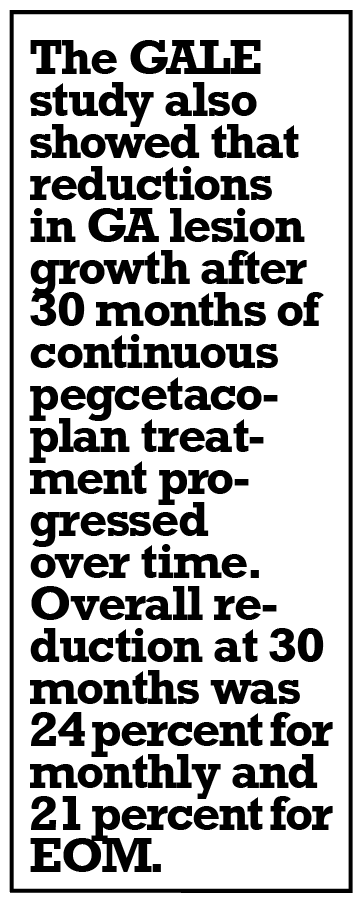 |
The study also showed that reductions in GA lesion growth after 30 months of continuous pegcetacoplan treatment progressed over time. At six months, the monthly arm had a 19 percent reduction and the EOM arm a 17 percent reduction vs. sham. In the modeled 30-month results, that gap had grown to 39 percent for monthly treatment and 32 percent for EOM. The overall reduction at 30 months was 24 percent for monthly and 21 percent for EOM (p<0.0001).
In patients with nonsubfoveal lesions, the difference was even more pronounced: 31 percent for monthly and 26 percent for EOM vs. sham (p<0.0001).
Dr. Steinle addressed the postmarket reports of intraocular inflammation, namely retinal vasculitis, after pegcetacoplan injection. No infectious endophthalmitis cases were reported in the first six months of GALE, and the rate of IOI in treated patients across OAKS, DERBY and GALE was 0.26 percent. In the interim, Apellis linked the cases of retinal vasculitis to the 19-gauge filter needle in certain injection kits and recommended retina specialists discontinue use of the kits in favor of kits with an 18-gauge needle instead.
Dr. Steinle is a consultant to and investigator for Apellis.
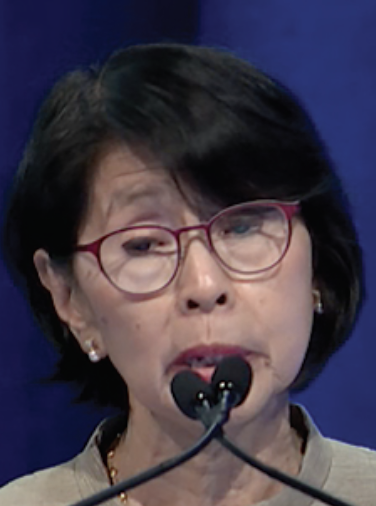 |
CNTF implant shows promise for treating MacTel type 2
Revakinagene taroretcel, also known as NT-501 (Neurotech Pharmaceuticals), is first-in-class encapsulated cell therapy that’s surgically implanted into the vitreous cavity via a capsule anchored to the sclera to produce sustained levels of ciliary neurotrophic factor (CNTF). Emily Chew, MD, of the National Eye Institute, reported on two Phase III studies evaluating the treatment in patients with macular telangiectasia type 2 (MacTel) vs. sham treatment.3
The NTMT-03-A and NTMT-03-B trials were identically designed and randomized patients 1:1 to NT-501 (n=58 and 59, respectively) or a sham procedure in the study eye (n=57 and 54). Inclusion criteria were ages 21 to 80 years and an ellipsoid zone break between 0.16 and 2 mm2 and BCVA of ≥54 letters.
The primary endpoint was rate of change in the area of EZ loss from baseline to month 24. Secondary efficacy outcomes were aggregate sensitivity of microperimetry within the EZ line break area and monocular reading speed at month 24. Secondary safety outcomes were the proportion of patients with a ≥15-letter loss in BCVA at any visit or one or more treatment-related serious adverse events.
In the A study, the treatment arm had a 0.074 mean change in EZ area loss vs. 0.170 for the sham arm (p<0.0001). The disparity in absolute size of EZ area loss at 24 months was similar, with a difference of -0.096 for treatment vs. sham (p<0.0001), leading to a 56.4- percent reduction in retinal degeneration for the treatment arm.
In the B study, the gaps between the treatment and sham arms were closer: 0.116 vs. 0.164 for mean change from baseline in EZ area loss at 24 months (p<0.0001); -0.048 difference in EZ area loss (p<0.0210); and a 29.2-percent reduction in retinal degeneration.
For the secondary endpoint of aggregate retinal sensitivity loss from baseline, the A trial demonstrated a mean change of 25.27 vs. 43.02 in the treatment vs. sham arms (p=0.0199), but the B trial showed no significant differences between the two arms.
The treatment arms in both studies had significantly higher levels of treatment-emergent adverse events (TEAEs), with 90 (n=52) and 93 percent (n=55) of NT-501 patients in the A and B trials vs. 60 (=34) and 41 percent (n=76) for the sham arms.
In terms of ocular TEAEs related to CNTF, 17 percent of treated patients in the A trial (n=10) and 24 percent in the B trial (n=14) had delayed dark adaptation, and 17 (n=10) and 14 percent (n=8), respectively, had miosis. One sham patient in the B trial had delayed dark adaptation.
Treatment with NT-501 preserved photoreceptors through 24 months in both trials, Dr. Chew said, demonstrating safety and efficacy for treatment of MacTel.
Dr. Chew has no relevant disclosures.
 |
Tarcocimab fails to meet trial endpoint
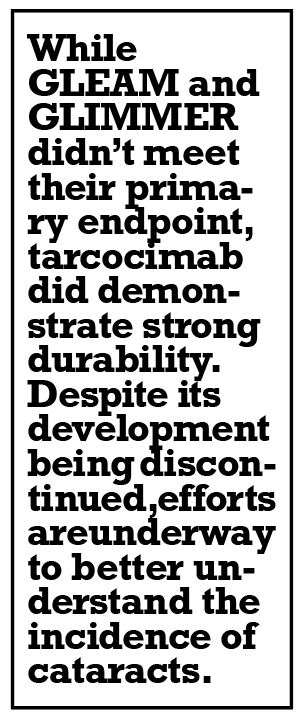 |
Retinal thickness outcomes were also similar between the treatment arms. In GLEAM, the mean change in central subfield thickness measured on optical coherence tomography was 151.6 (127.1) µm for tarcocimab and 142.8 (135.1) µm for aflibercept. In GLIMMER, those respective outcomes were 190.9 (154.7) µm and 159 (135.6) µm.
For ocular adverse events (OAE), tarcocimab patients had significantly higher rates of cataract—19.4 percent (n=89) vs. 8.7 percent (n=40) in the pooled analysis of both studies.
The mean BCVA change curve trajectories of tarcocimab and aflibercept trended upward until week 36, when they started to separate, when the tarcocimab curve trended downward. The higher rates of cataract in the tarcocimab arms emerged after 36 weeks.
Rates of any OAE were 48 percent (n=220) in the pooled tarcocimab arms and 34.9 percent (n=160) in the aflibercept arms. Rates of intraocular inflammation were low in both treatment groups and endophthalmitis rates were similar between both treatment and sham groups. Neither study had any cases of IOI with vasculitis or vascular occlusion.
When pseudophakic patients were separated out, the BCVA and OCT CST outcomes were more evenly matched between the tarcocimab (n=108) and aflibercept (n=112) arms.
While GLEAM and GLIMMER didn’t meet their primary endpoint, tarcocimab did demonstrate strong durability, Dr. Wykoff said. However, cataracts compromised the drug’s vision outcomes. Despite its development being discontinued, efforts are underway to better understand the incidence of cataracts.
Dr. Wykoff is Chief Medical Editor of Retina Specialist Magazine and a consultant to and investigator for Kodiak Sciences. RS
REFERENCES
1. Heier J. Treatment of geographic atrophy secondary to age-related macular degeneration with intravitreal ANX007: Results of the ARCHER Study. Paper presented at the American Society of Retina Specialists; Seattle, WA; July 30, 2023.
2. Steinle N. Long-term efficacy of pegcetacoplan in patients with geographic atrophy. Paper presented at ASRS; Seattle, WA; July 30, 2023.
3. Chew E. Phase 3 randomized studies of efficacy and safety of revakinagene taroretcel producing ciliary neurotrophic factor (CNTF) in macular telangiectasia type 2. Paper presented at ASRS; Seattle, WA; July 30, 2023.
4. Wykoff C. Tarcocimab tedromer (KSI-301) anti-VEGF antibody biopolymer conjugate for DME: First-time efficacy, durability and safety results of the GLEAM and GLIMMER Phase 3 studies. Paper presented at ASRS; Seattle, WA; July 30, 2023.



